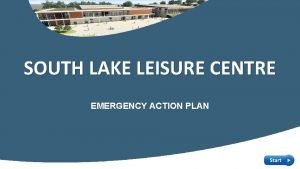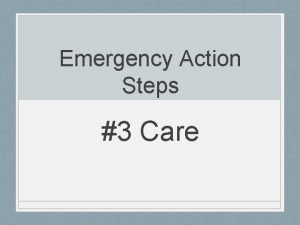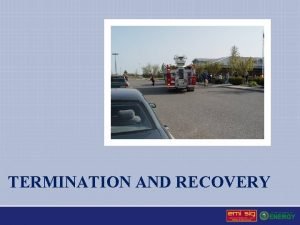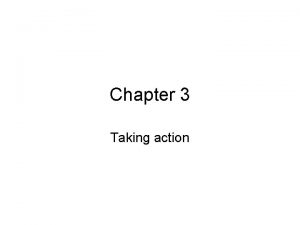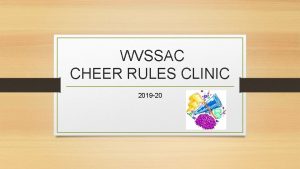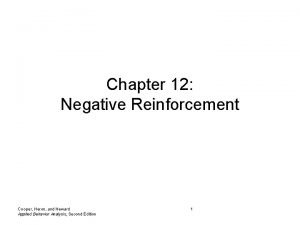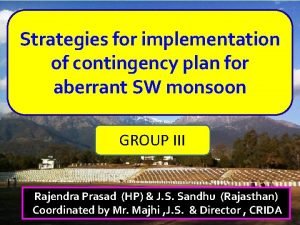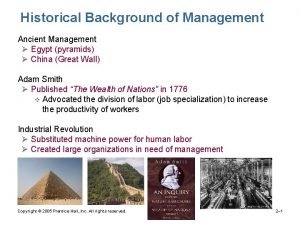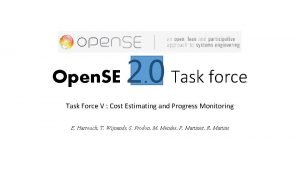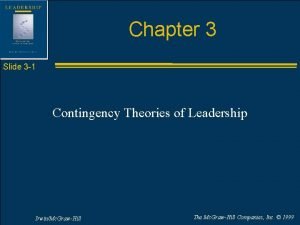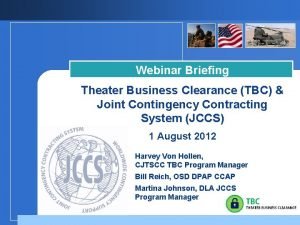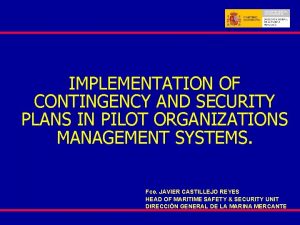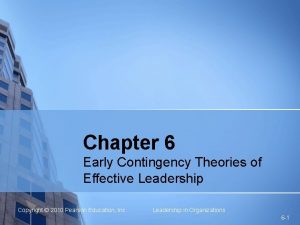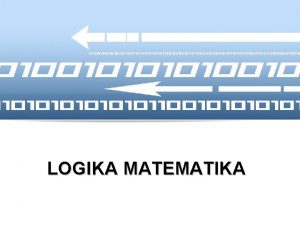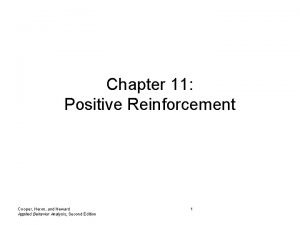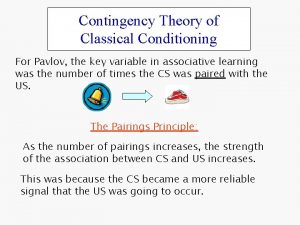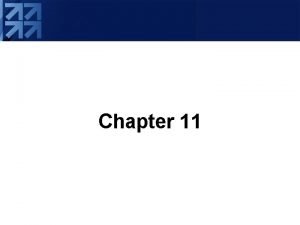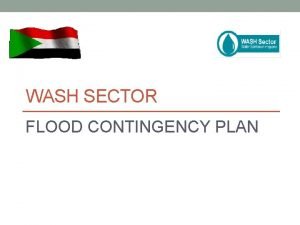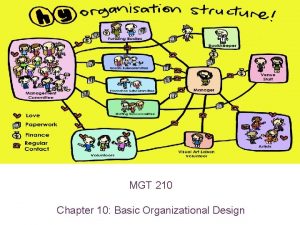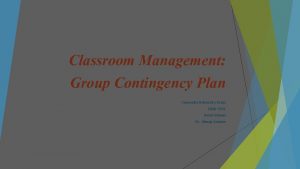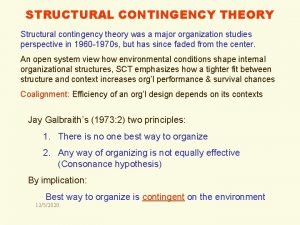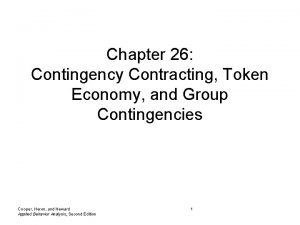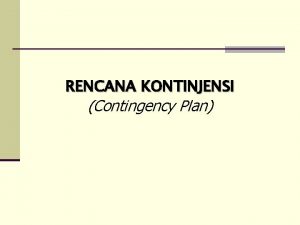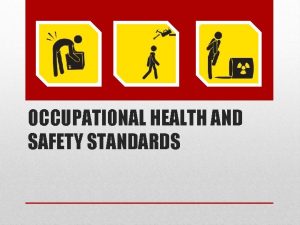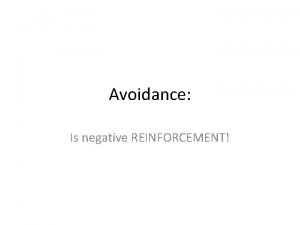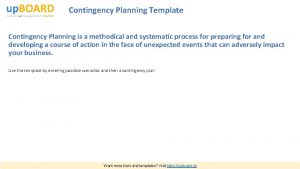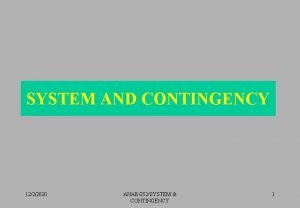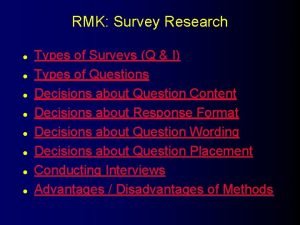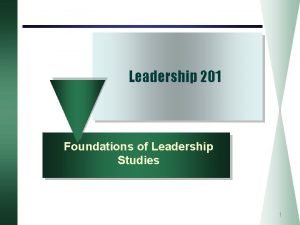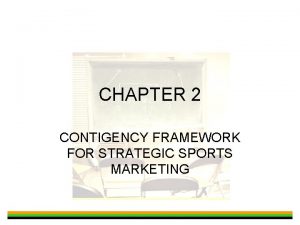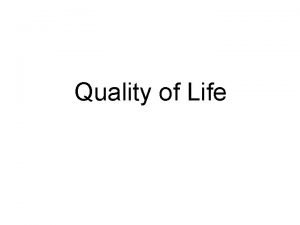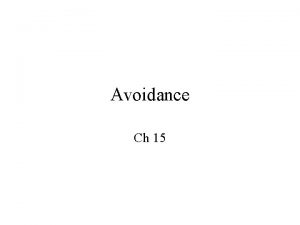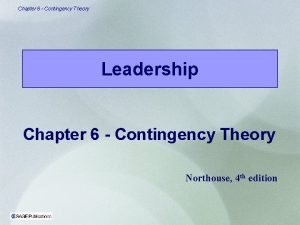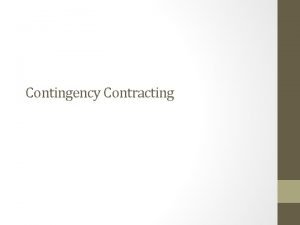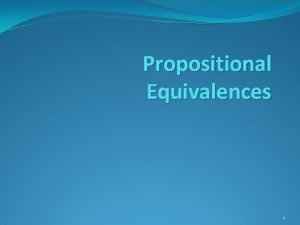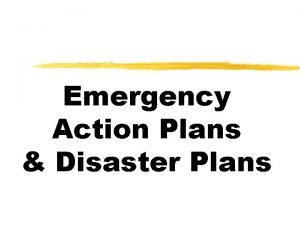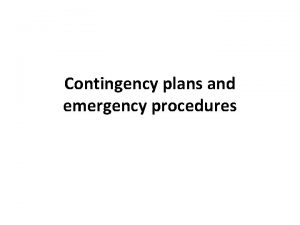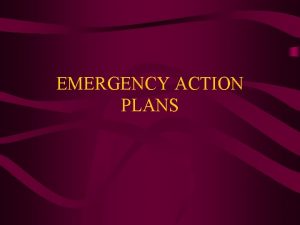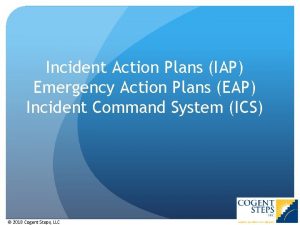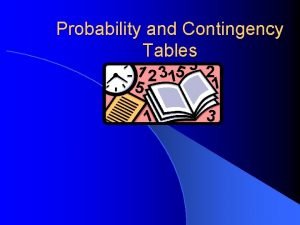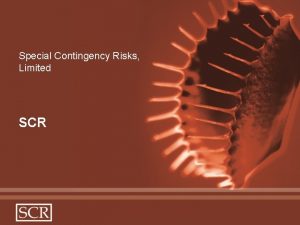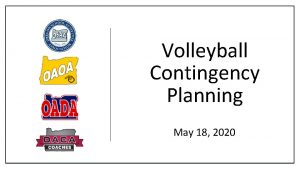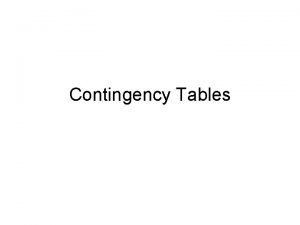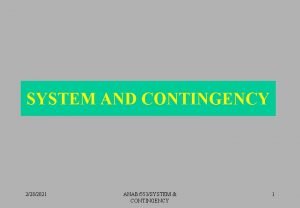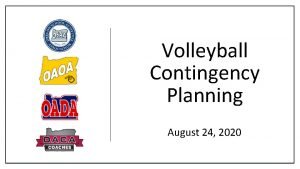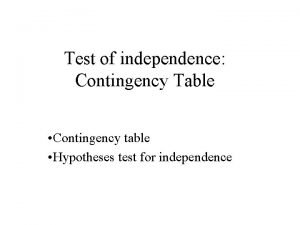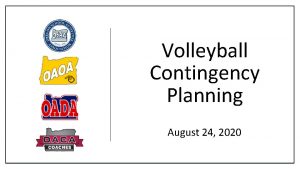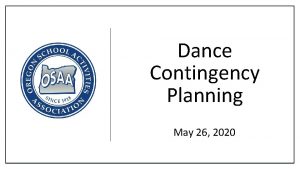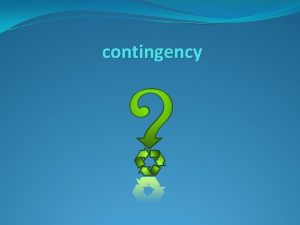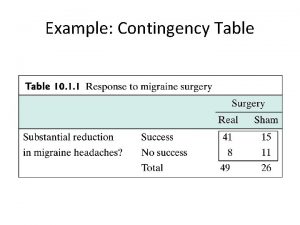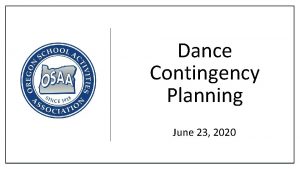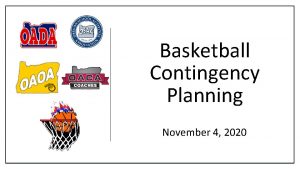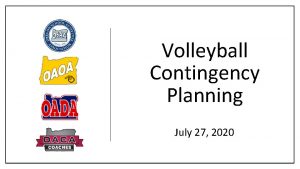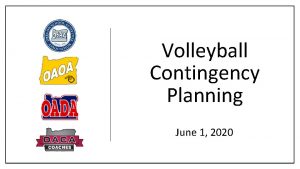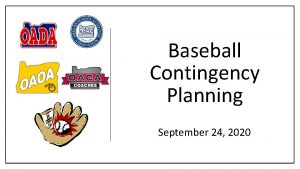CONTINGENCY EMERGENCY ACTION PLANS EAPS Emergency action plans













































- Slides: 45

CONTINGENCY / EMERGENCY ACTION PLANS (EAPS)

• Emergency action plans EAPS , simply describe the actions a safety officer should take to ensure their safety in case of any emergency. Eg fire

NOTE! • An emergency action plan should be drawn irrespective of how professional your JHA may be. EAP • Every Contingency plan should be constantly practiced (drill) to ensure employees full understand it.

- An EAP must be in writing format. - DRILLS should be continuously performed until it is obvious every employee understands it perfectly.

REASONS FOR DRILLS ARE TO: - Familiarize personnel with the contents of the plan. - Acquaint personnel with their emergency duties and responsibilities. - Evaluate the plan to determine its workability - Identify deficiencies and make necessary correction or adjustment

WHAT DO YOU PLAN AGAINST? • Security issue (hostages, robberies, etc. ) • Hazardous materials incident • Fire • Flood. • Earthquake etc • Building / equipment collapse

EMERGENCY ACTION PLANS (EAPS) All EAPS MUST HAVE THE FOLLOWING • All EAPs must have the following: • Procedures for reporting a fire or other emergency • Procedures for emergency evacuation, including the type of evacuation and exit route assignments

EMERGENCY ACTION PLANS (EAPS) All EAPS MUST HAVE THE FOLLOWING • Procedures to be followed by employees who must remain behind to operate critical plant/facility equipment/operations before they evacuate

IN YOUR EAP PLANING PROCESS THESE ELEMENTS SHOULD BE ADDRESSED: • Preferred procedures for reporting emergencies, such as dialing a particular phone number or using a manual fire alarm. • A description of the alarm system to be used to notify employees.

EVACUATION PLANS Well detailed evacuation map should be developed. • All exits should be identified on the map. • Location of fire extinguishers should be identified.

EMERGENCY ACTION PLANS (EAPS) SIMPLE EVACUATION MAP

STRESS MANAGEMENT SIGN AND SYMPTOMS OF STRESS

STRESS MANAGEMENT • Stress is not an illness. It is a state however if stress becomes too much or prolonged it can lead to illness or mental Derain.

WHO CAN BE AFFECTED WITH STRESS ? • • • Stress affects the equipment operators The technicians / Engineers The contractors The casuals even the managers

WHAT COURSES STRESS? • • Level and nature of workload Work patterns & environment Priority setting and time pressures Excessive hours Repetitive work Unrealistic deadlines constant inspections

WHAT MORE CAN COURSES STRESS • • • Background / culture Life experience Personalities Personal circumstances Health status

NOTE: Stress affects people in different ways, what one person finds stressful might be normal to another.

Symptoms of stress • • • Negative or depressive feeling Disappointment with yourself Increased emotional reactions (tears, anger) Cant concentrate Confusion , poor decisions

MANAGING STRESS Stress is best managed at individual level, its also the duties of management to investigate her workplace to determine if people are really stressed. One best strategy for the safety officer is to sample workers opinion and request management to act on them.

JOURNEY MANAGEMENT

JOURNEY MANAGEMENT Journey management includes plans, procedures involved in the safe and efficient transportation of goods and personnel over land, air and water.

WHAT JOURNEY SHOULD BE MANAGED? Any journey carried out in the pursuit of companies business whether by company or its contractor should be managed according to required standard.

WHY SHOULD A JOURNEY BE MANAGED? - A Journey in its self is a potential risk if not managed properly can course a serious hazard. - A planed journey documents serves as a very good guideline. - A planed and well managed journey is often smoothly coordination.

PERSONALITIES IN JOURNEY MANAGEMENT: managing journeys is not left for the HSE officer only, quality journey management usually involves every arm: - The authorizing person - the journey manager - The drivers - the passengers (the management) (appointed by management) (persons involved in the journey)

RESPONSIBILITIES OF PERSONALITIES IN JOURNEY MANAGEMENT: RESPONSIBILITIES OF THE AUTHORIZING PERSON: - He / she is responsible for appointing journey managers - The supervisors and the drivers report to him / her.

RESPONSIBILITIES OF THE JOURNEY MANAGERS: - The journey manager is responsible for the planning, monitoring and the analysis of the journey. - The journey manager remains responsible for the vehicle, the drivers and the passenger until the return to base.

RESPONSIBILITIES OF THE DRIVER: - The driver should only drive on instruction. - The driver should always state the conditions of his vehicle, the load, etc, he should always make sure things are going accordance to the journey plans.

RESPONSIBILITIES OF THE DRIVER ( CONTN): - The driver should not move until he has received and understood the journey plan, and also the manifest. - The driver shall contact the journey manager if there any problems or difficulties en-route and other dealings.

RESPONSIBILITIES OF THE PASSENGER: - The passenger must wear life saving belt’. - The passenger should ensure no unauthorized passengers are carried on the way by the driver. - They should ensure the driver adheres to the journey plan by quickly reporting any wrong move to the journey manager.

DEFENSIVE DRIVING - Defensive driving is driving to prevent accidents or collision in spite of the incorrect actions of others - Other road users and the adverse conditions around you the driver and thus save lives, time, money and properties.

THE SIX ADVERSE CONDITIONS - LIGHT WEATHER ROAD TRAFFIC VEHICLE DRIVER

BAD LIGHTINGS low or high have negative effects on drivers.

BAD LIGHTINGS FOR LOW LIGHT PROBLEM: Poor vision SOLUTION: - Turn on your full head lamp Or Pull over completely

BAD LIGHTINGS FOR VERY BRIGHT LIGHTS Problem: Poor vision Solution: <vehicle behind> Adjust Rear-view marrow <vehicle in front> Reduce speed or Pull over

MORE SO FOR VERY BRIGHT LIGHT • Turn the rear view away completely so the light rays do not strike your Eyes directly, slowdown and let the vehicle go in front of you. - For lights from the on-coming vehicle, Communicate twice to the driver by flashing Your lights, if the driver falls to turn down the high beam then slowdown till he passes by. For this case, Please park if you can't see clearly, it usually takes 4 7 seconds to recover sight.

DEFENSIVE DRIVING WEATHER: In weathers like rain, dews (harmrmattan) and high winds DO THE FELLOWING: - Increase following distance - Put on low beam headlights - Park if the rain is very heavy

DEFENSIVE DRIVING ROAD NOTE: study the characteristics of the road you are driving on as this will determine how you will drive. What to study The shape, road surface, shoulder, - Reduce speed if the road condition is very bad or if the road is new to you.

DEFENSIVE DRIVING TRAFFIC: means everything using the road INPORTANTLY: - Avoid the rush hours and congested routes whenever possible. - Be considerate, don’t claim right if this is necessary to prevent a collision.

THE DRIVER - Drivers error accounts 70% of all collision. - FACTOR THAT AFFECTS DRIVERS - Age – attitude – alcohol - fatigue – emotions

PERFECT TRIP:

PERFECT TRIP - A perfect trip is one completed without any of the five driving errors: - COLLISIONS - TRAFFIC VIOLATIONS - VEHICLE ABUSE - SCHEDULE DELAYS A defensive driver aims at making perfect trips always.

PERFECT TRIP A defensive driver aims at making perfect trips always.

PERSONAL HYGIENE Dirty hands is a gateway to all kinds of sickness!

PERSONAL HYGIENE Make sure you keep yourself clean always! >Wash your hands always, >> do your laundry, >>> wash your mouth >>>> Take clean berth before / after work

PERSONAL HYGIENE Many company take personal hygiene seriously be wise and save Your job! >Good personal hygiene keeps you away from sickness >Good personal hygiene can even determine your relationship with others.
 Dr abcde first aid
Dr abcde first aid What are the emergency action steps
What are the emergency action steps Drowning emergency action plan
Drowning emergency action plan What are the 3 emergency action steps?
What are the 3 emergency action steps? Emergency action termination
Emergency action termination What are the 3 emergency action steps
What are the 3 emergency action steps Wvssac eligibility rules
Wvssac eligibility rules Negative reinforcement
Negative reinforcement Contingency crop planning
Contingency crop planning Historical background of management
Historical background of management Contingency reserve vs management reserve
Contingency reserve vs management reserve Servant leader vs contingency plan
Servant leader vs contingency plan Loss contingency journal entry
Loss contingency journal entry Contingency theory of leadership
Contingency theory of leadership Tec login
Tec login Special contingency risks
Special contingency risks Early contingency theories of effective leadership
Early contingency theories of effective leadership Tautologi matematika
Tautologi matematika Cooper heron heward
Cooper heron heward Contingency theory classical conditioning
Contingency theory classical conditioning Special contingency risks
Special contingency risks Flood contingency plan
Flood contingency plan Specialization
Specialization Group contingency plan
Group contingency plan Contingent liability journal entry
Contingent liability journal entry Structural contingency
Structural contingency Contingency contract aba
Contingency contract aba Laboratory contingency plan example
Laboratory contingency plan example Contingency plan template
Contingency plan template Contingency measures during workplace accidents
Contingency measures during workplace accidents In an avoidance contingency:
In an avoidance contingency: Contingency plan template
Contingency plan template Agamemnon contingency
Agamemnon contingency Stace-dunphy contingency matrix
Stace-dunphy contingency matrix Contingency questions/cascade format
Contingency questions/cascade format Contingency table in statistics
Contingency table in statistics Theoretical foundation of leadership
Theoretical foundation of leadership Contingency framework for strategic sports marketing
Contingency framework for strategic sports marketing What is contingent contract
What is contingent contract Levels of communication
Levels of communication Robert rescorla contingency model
Robert rescorla contingency model Avoidance contingency
Avoidance contingency Lpc scale contingency theory
Lpc scale contingency theory Kalam cosmological argument
Kalam cosmological argument Behavioral contracting
Behavioral contracting Equivalence truth table
Equivalence truth table
